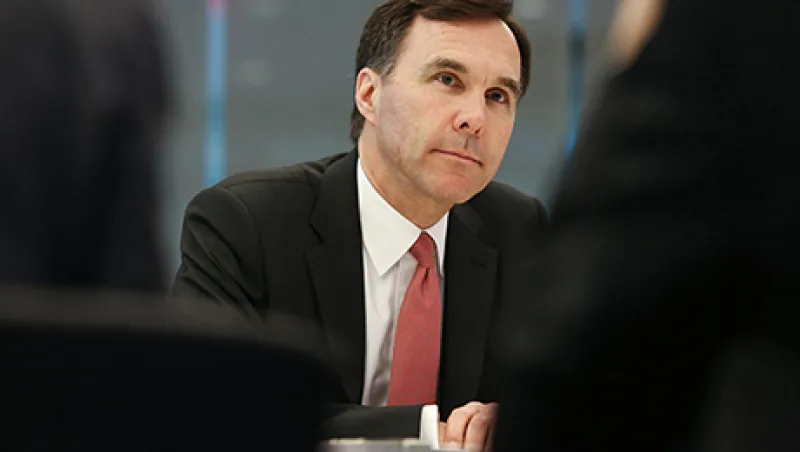The world has come to know Justin Trudeau, Canada’s new prime minister, as a man who snuggles with panda cubs and practices yoga on his desk when he’s not pushing his center-left agenda. Now the financial world is meeting the rookie politician who might be considered Trudeau’s straight man: Finance Minister Bill Morneau.
Morneau, 53, recently visited New York, London and Paris to spread the word about Canada’s new stimulus plan. At a Canadian Association of New York luncheon on March 30, the former business executive told the crowd that investing in growth for the long term is “the single best thing we can do to make Canada a destination for investors.” Ensuring that the economy is vibrant and competitive across diverse industries will counteract the country’s massive losses in the energy sector, he added.
As head of the Liberal Party, Trudeau won last fall’s election partly by pledging to spend big to boost the middle class. Although opponents promised balanced budgets, he said his government would run a deficit of C$10 billion ($7.6 billion) in its first year to pay for things like a more generous child benefit plan, which gives families a tax-free allowance tied to income, and job creation measures. When Morneau released his first budget, on March 22, the deficit had grown to C$29.4 billion, or 1.5 percent of gross domestic product, for 2016 and C$29 billion for 2017, with smaller shortfalls to follow.
Ottawa will spend C$120 billion on infrastructure over the next decade, starting with public transit, water, housing and waste management projects. Among the other priorities he outlined: so-called innovation hubs where entrepreneurs and academic researchers can mingle, university labs and research facilities, and green technology.
Phase 2 of the plan, to be released next year, will include ambitious longer-term infrastructure investments, Morneau told the New York audience. In addition, the government will be “seeking ways to amplify the benefits of those investments by working with provinces and municipalities, but also by creating opportunities for institutional investors to come,” he added.
Morneau, who became a member of parliament last year after serving as executive chair and CEO of Morneau Shepell, a human resources services firm founded by his father that he helped to grow into Canada’s largest pension administrator, said that his party sees the budget as a blueprint for other economies confronting sluggish growth. Studies consistently show that every $1 spent on infrastructure leads to more than $1 in economic activity, he asserted.
The Liberal plan will create 100,000 jobs, according to the party’s forecasts. Investing in technological innovations to help Canada shift to a lower-carbon economy should open up new global markets to Canadian companies, Morneau argued.
Canada is in a unique position to spend because it has the lowest debt-to–GDP ratio among the Group of Seven nations, he noted. Now 31 percent, that number is expected to edge up in the short term but return to roughly its current level in five years.
Morneau, a trim runner who holds a master’s degree in economics from the London School of Economics and an MBA from France’s INSEAD, is an unknown quantity to his international counterparts and foreign investors, but at home he’s regarded as a shrewd businessman with a social conscience.
After taking control of Toronto-based Morneau Shepell in 1990, he led a series of acquisitions that pushed the firm’s annual revenue from C$20 million to C$500 million. Morneau’s public service record includes a stint as chair of Covenant House Toronto, a group that supports homeless youth, and spearheading a corporate partnership with the United Nations to build a girls’ high school in Kenya’s Kakuma refugee camp.
Jack Mintz, a public policy professor at the University of Calgary, says he welcomes Morneau’s infrastructure spending. But other new measures — like lowering the retirement age to 65 from 67, reversing a hike by the previous, Conservative government — will feed a demographics-fueled “debt bomb,” Mintz fears.
“I’m concerned that investors may take a look at Canada and decide it’s heading back to the 1970s,” he tells Institutional Investor, referring to the period when Justin Trudeau’s father, Pierre, was in power and ran large deficits.
The reaction from Bay Street, the heart of Toronto’s financial district, suggests that investors don’t regard the spending agenda as particularly risky. Since the budget was released, yields on long-term Canadian government bonds have fallen slightly, and the ratings agencies haven’t made any changes. Fitch Ratings said that the new debt could limit the government’s ability to respond to an economic shock, but it also noted that the deficits were expected and that they complement monetary policy, the Globe and Mail reported.
Morneau’s plan is sustainable, at least for now, according to economist Matthew Stewart, an associate director at Ottawa-based think tank the Conference Board of Canada. This is not an “anti-austerity budget,” as some have dubbed it, he argues.
Canadian federal government spending relative to GDP will rise by less than 1 percentage point this year, to 14.9 percent, according to Royal Bank of Canada, and the first-year deficit is based on an annual GDP growth rate of 1 percent in 2016, lower than the 1.4 percent that private sector economists have forecast. “They’ve given themselves a lot of room to do better,” Stewart says.
Now there’s even more room, thanks to January’s 0.6 percent GDP growth, which doubled the consensus projection. BMO Financial Group and Toronto-Dominion Bank have adjusted their 2016 forecasts for GDP expansion upward, to 1.8 and 1.9 percent, respectively.
Numbers like those give Morneau a solid base to build upon.






